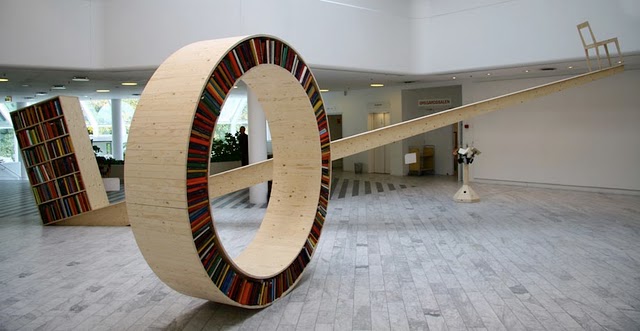
David Garcia Studio; Click for more.
Core77 picks up the circular bookshelf mentioned here in an earlier installment in this Murketing.com series, and notes the creator (whose name I didn’t have): David Garcia.
More to the point, Core77’s item cites this Dvice post, which in turn cites a blog called Bookshelf: The home of interesting bookshelves, bookcases and things that look like them — which is an absolute stunning trove of bookshelf/case-related images. I’ve just spent half an hour click through the archives and barely made a dent. In addition to several of the things from this series there’s a ton of stuff that should be in this series (and perhaps will be). It’s really an amazing blog.
In addition, one Bookshelf blog item is about a site called Lookshelves, whose proprietor asks people to send in pictures of their shelved books and answer a few questions. Meghan Beresford explains:
When I go to someone’s house, I am immediately drawn to their bookshelves. I want to know what they read (or buy), how they display their books, what’s well-thumbed and what’s in the darkish corners. I want to stumble into their secret interest in banjo, or ouija boards, or the Ottoman Empire. I love seeing that we’ve read the same thing, or being reminded that I meant to read that book, or seeing a bunch of books by an author I’ve never heard of right next to a writer I know and love. For all of these reasons, I love bookshelves.
More on this later, too.
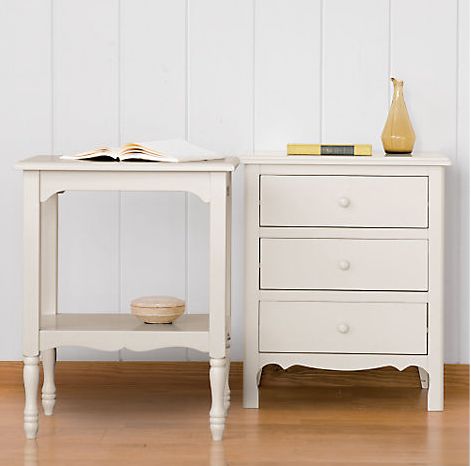
“What is it with all these books?” Nicholson Baker asked in the 1995 New Yorker piece about books used as props in catalogs (as mentioned yesterday). And given that date it’s a little surprising that he continues: “Isn’t the Book supposed to be in decline – its authority eroding, its informational tax based fleeing to suburbs of impeccably edged and weeded silicon?”
Fifteen years later, that’s still the conventional wisdom. (Which doesn’t mean it’s wrong – just that like so much of today’s digital euphoria, it’s really familiar. Sometimes it amazes me how little has changed in the past decade and a half. But that’s another story.) Baker’s story wasn’t about the future of publishing, it was about what books, as objects, signify — after all, those catalog pages weren’t full of random cassettes, or old magazines, or stray cell phones. I mentioned some of his answers in yesterday’s post.
What I got curious about is whether, fifteen years later, books still serve this sort of function – not in mail-order catalogs, per se, but in their online descendants. I spent a bit of time poking around the site of The Company Store. Poking around a web site is a far different experience than paging through a catalog — much more lean-forward, as they say, clicking and making decisions instead of idly following the flow while letting the mind wander. But I found a few things before I got tired of the exercise.
At the top of this post is the Romantic Table Collection (it now seems to have disappeared from the site) — included a couple of volumes in a manner that I suspect would have fit right in with the catalog imagery Baker pondered a decade and a half ago. Below: Vivid Ottoman. I enjoy this use of books as props, because the little stack on the left is being deployed, somewhat absurdly, as a superfluous and probably unwieldy stand for a vase. This seems to degrade the of the book, if you ask me: The possibility of these books being opened is basically eliminated; books become just things lying around to be put to some kind of “use,” however pointless.
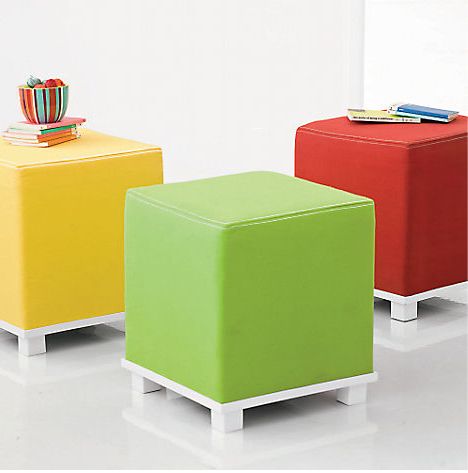
In this entry for Colorblock Bedding (also now gone), I noticed the books under the nightstand, but …
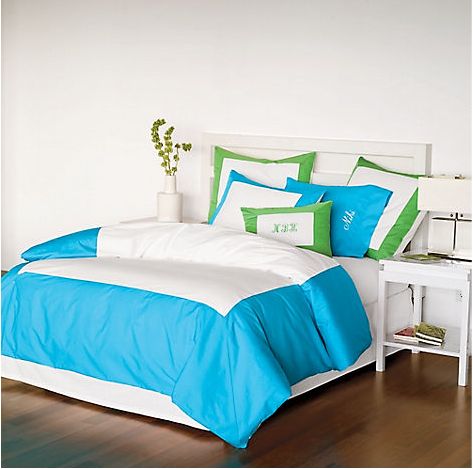
… what’s odd is that if you look closer you’ll notice that these appear to be two identical copies of each of two books. What would explain this? Baker noted certain books popping up in multiple photographs in a single catalog — but multiple copies of the same title in the same image? This seems like sloppiness on the part of the props person, no? And again: a bit of an insult to the idea of the book.
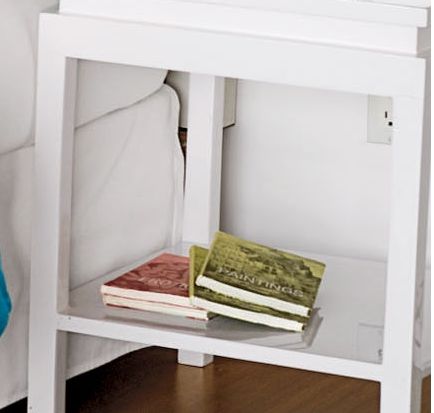
One more post related to the Baker piece next week – sorry to go on about it, but there’s so much in that seems important to the this occasional series on idea of the book.
Posted Under:
The Designed Life
This post was written by Rob Walker on April 23, 2010
Comments Off on The idea of the book: Catalog props revisited
- Brief meditative exercise helps cognition: “Some of us need regular amounts of coffee or other chemical enhancers to make us cognitively sharper. A newly published study suggests perhaps a brief bit of meditation would prepare us just as well.”
- Motivated Multitasking: How the Brain Keeps Tabs on Two Tasks at Once: So this study suggests that under some circumstances, “rather than being totally devoted to one goal at a time, the human brain can distribute two goals to different hemispheres to keep them both in mind.” But then the story quotes an expert contending that “the new work does not, however, show that the brain can actually execute two distinct tasks at precisely the same time.” Huh? Well is this evidence of something new or just the same continuous partial attention framework that’s already been established? I don’t get it.
- The “recycled suit” totebag: From Poketo.
- Dept. of startling cynicism: Art Fag City in retracting its (apparently false) accusation that Wooster Collective “had to be” getting money to hype the Banksy movie: “It never occurred to me that anyone would so aggressively promote a movie over twitter and [a blog] without payment.” Wow, is that what it’s come to?
These links compiled via delicious, and repurposed here with plug-in Postalicious. Not enough stuff? Not the stuff you wanted? Try visiting unconsumption.tumblr.com, murketing.tumblr.com, and/or the Consumed Facebook page.
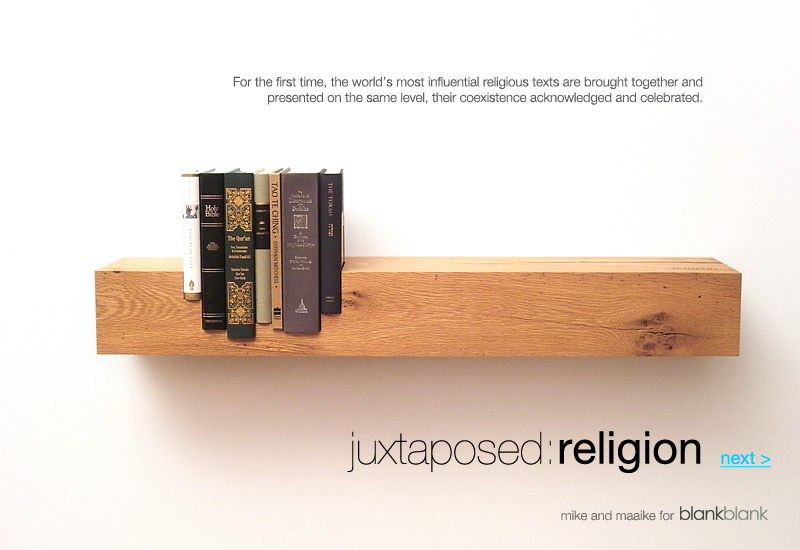
Click for more.
This shelf and set of religious texts are (or I guess were) sold together — the idea is the world’s religions are “presented on the same level,” according to BlankBlank. I suppose you could read the books, too; or you could simply co-sign on the general concept and treat this as a statement of your enlightenment, and leave it at that. Note that the shelf, while taking a rough-and-ready “reclaimed hardwood” form, is elegantly branded:
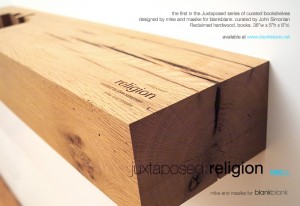
This was the first in a “series of curated bookshelves.” The second in that series: “Seven of the world’s most seminal texts on power and its relationship to the ordering of society are brought together and presented on the same level.”
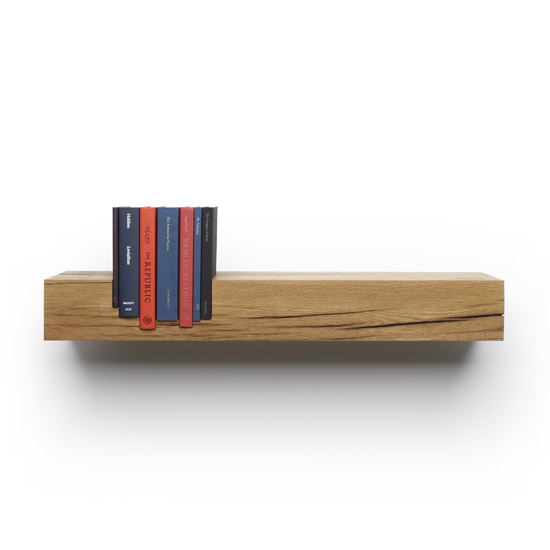
Power. Click for more.
The books: Leviathan by Thomas Hobbes, The Federalist Papers by James Madison, Alexander Hamilton, and John Jay, The Republic by Plato, On Liberty by John Stuart Mill, The Communist Manifesto by Karl Marx, The Conquest of Bread by Peter Kropotkin, and Social Justice in Islam by Sayyid Qutb.
The price is $3,000.
I’m thinking a wall-decal version might a good alternative to offer entry-level consumers. (And perhaps a small, sticker version to put on a mobile reader device?)
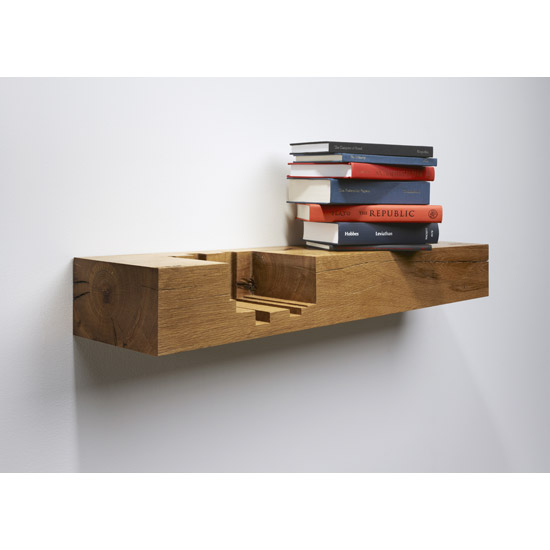 Part of a series. Thx for the tip: Harold.
Part of a series. Thx for the tip: Harold.
Posted Under:
The Designed Life
This post was written by Rob Walker on April 23, 2010
Comments Off on Books, the idea, cont’d: the “curated bookshelf”
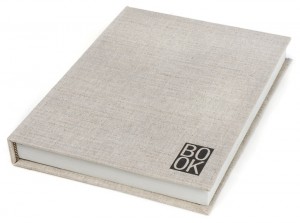 This was commented earlier, but here is BOOK.
This was commented earlier, but here is BOOK.
Designed by two Minnesotan bibliophiles, BOOK began as a project to produce artist’s monographs. After designing and constructing our first book, we realized that the book jacket is a time-tested method of protection applicable to other materials beyond pages. While we believe that that BOOK is a great companion for digital devices, we also believe in the power of paper books. A portion of the profits from BOOK will be used toward producing artists’ books at Location Books.
The upshot is something that makes your e-reader look like a real book — albeit not a specific book, but just, well, the idea of a book.
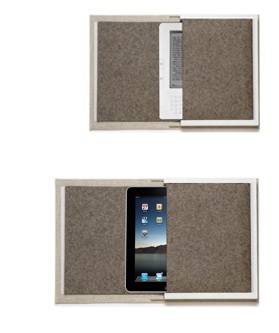 In a sense the Kindle version is a higher-end take on Busted Typewriter’s revision of books into device-holders. (You will recall the Buying In iteration.) What I’m more curious about is the iPad version. The iPad strikes me as a display device — people who buy these want to wave them around and accrue status via their prize possession, don’t they? But maybe that’s not fair. Perhaps there is a segment of the iPad early adopter public that is sheepish-to-modest about the gadget, and prefers to keep it on the low? If so, here is the $89 solution.
In a sense the Kindle version is a higher-end take on Busted Typewriter’s revision of books into device-holders. (You will recall the Buying In iteration.) What I’m more curious about is the iPad version. The iPad strikes me as a display device — people who buy these want to wave them around and accrue status via their prize possession, don’t they? But maybe that’s not fair. Perhaps there is a segment of the iPad early adopter public that is sheepish-to-modest about the gadget, and prefers to keep it on the low? If so, here is the $89 solution.
Posted Under:
Uncategorized
This post was written by Rob Walker on April 22, 2010
Comments Off on Books, the idea, cont’d: Disguising your Kindle .. or iPad?
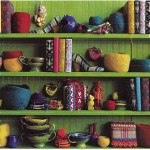 A couple of weeks ago now I mentioned Nicholson Baker’s piece, “Books as Furniture,” from the June 12, 1995 New Yorker. (Thx again Jim Rosenau.) Like much of Baker’s best work, it’s based on simply noticing something that seems curious — and going to fantastic lengths to explain what that something is all about.
A couple of weeks ago now I mentioned Nicholson Baker’s piece, “Books as Furniture,” from the June 12, 1995 New Yorker. (Thx again Jim Rosenau.) Like much of Baker’s best work, it’s based on simply noticing something that seems curious — and going to fantastic lengths to explain what that something is all about.
In this instance, what he noticed was how frequently mail-order catalogs for furniture and clothing other lifestyle-product companies featured, as casual props in their carefully staged photographs, books. Along the way he makes several observations that, in addition to being quite relevant to this site’s occasional series on the idea of the book, are also just flat-out wonderful.
Poring over catalogs from The Company Store, Crate & Barrell, Crabtree & Evelyn, Tweeds, J. Crew, etc., Baker spotted book after book. Though their titles were often illegible, and many seemed chosen more for the color of the spine than whatever was on their pages, it was nonetheless the case that these images were
surrounding printed fiction with life-size fictional rooms that resemble our own real rooms except that they are a good deal neater, costlier, and more literate….
There isn’t a self-help book or current best-seller to be seen, because the men and women who live in the rooms of the mail-order catalogues never read best sellers. In fact, they never read paperbacks.
This leads into a highly useful history of book display, going back to the first century, “when some books were still published – that is, multiply copied – on rolls (volumina), and stored on their sides” in armoire-like cabinets that were the precursors to the bookcase, “with little tags hanging from their ends which bore their titles.” A Pottery Barn catalog perused by Baker alludes to this history in the blurb for an armoire. “But can its copywriter truly believe that anyone is now going to keep a book collection behind the closed pine doors of a nine-hundred-and-ninety-nine-dollar cupboard?” He answers: No.
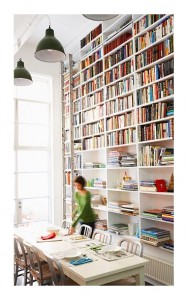
Catalog designers know perfectly well that books, if we are fortunate enough to own any, should be out there somewhere, visible, shelved in motley ranks or heaped on tables as nodes of compacted linearity that arrest the casual eye and suggest wealths of patriarchal, or matriarchal, learnedess.
Unlike other collectibles, books “represent a different order of plenitude,” Baker writes, one that encompasses “the camel caravans of thought-bearing time to read them through.” And he quotes William Gladstone arguing against a fashion for ornamental bookcases; those objects should remain plain, Gladstone says, because books “are themselves the ornament.”
Is the fate of this ornament at long last threatened? That’s been an undercurrent of this series, I suppose. Or maybe it’s more accurate to say that I think this series has been suggesting that the ornament will survive, but will also evolve. Whether books have a future or not, I think the idea of the book does.
More on this tomorrow.
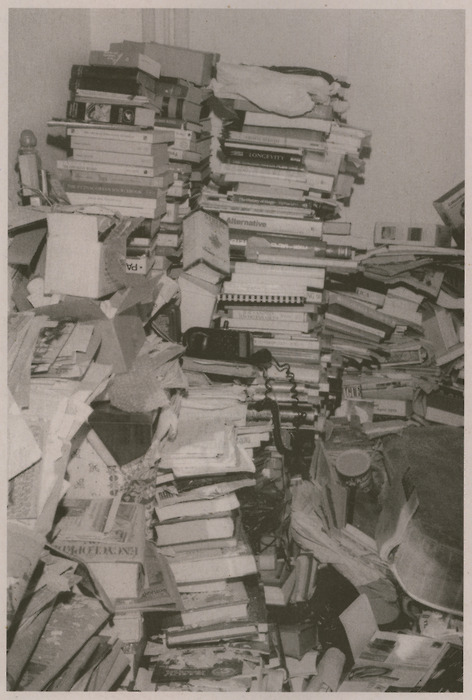
Public Collectors says: “Scanned from The Plan by Michael Schmelling, 2009, J&L Books, Atlanta. ‘Between 2003 and 2005 Michael Schmelling photographed various homes and apartments in the company of Disaster Masters, a New York-based agency that specializes in cleaning homes and counseling hoarders.’” Via Dinosaurs and Robots.
This would be a non-joyous version of clutter. (Joy and clutter also discussed here, as part of this series; and here on the Aesthetics of Joy blog.)
Posted Under:
Things/Thinking
This post was written by Rob Walker on April 22, 2010
Comments Off on Pictures of stuff, cont’d: The not-appealing hoard
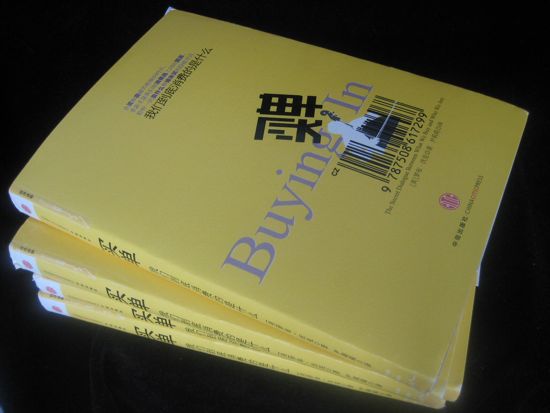
I got four copies of the “simplified Chinese” translation of Buying In today. Pretty cool, although I’m not sure what to do with four copies. Paging through, it was fun to look at the words and phrases (basically brand names and slang) that are I guess either untranslated or rendered in both languages for clarity.
Anyway it’s kind of a nice book, physically speaking.
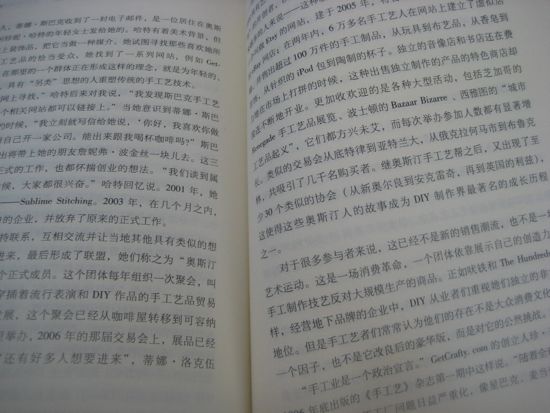
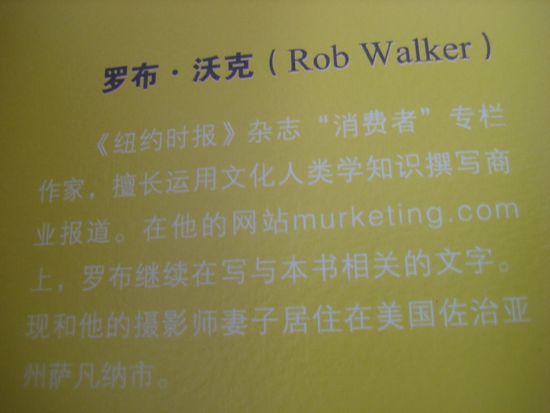
Disassembled household appliances photographed by Brittny Badger, via the invaluable Junk Culture.

Can Opener; click for more.
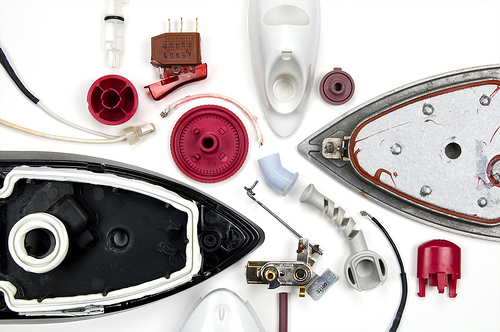
Iron; click for more.
See also Adam Voorhees’ “Exploded” images, noted early on in this series of posts.
Posted Under:
Artists
This post was written by Rob Walker on April 21, 2010
Comments Off on Pictures of stuff, cont’d: Disassembled
PSFK points out these recent fake products evidently placed in retail locations by TrustoCorp. An example of shopdropping, a form of semiotic disobedience discussed earlier on this site here and here (and also here, when shopdropping was, oddly, picked up as an alleged “trend” by a murketer). Some of these are fun, and an interesting example of using imaginary brands in the real world.

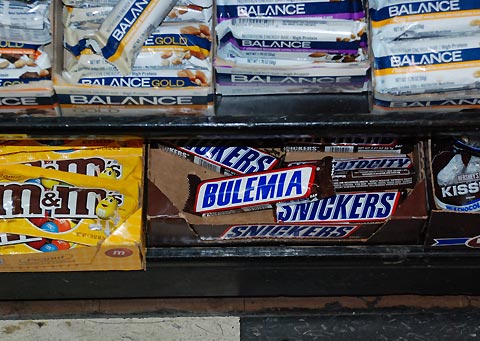


- Constriction to force ourselves to create: Jack White: “Only having red, white and black colors on any of the artwork or presentation of aesthetics of the band, guitar drums and vocals, storytelling melody and rhythm, revolving all these things around the number three, all these components force us to create.” Related post on rules, creativity, and book cover design, here.
- Monocle magazine funds foreign bureau on sales of tote bags: How did I miss this?
- What’s a YouTube phenomenon worth?: David after Dentist guy: “We’ve made in excess of $100,000. Significantly over that, you know, low six figures.”
- Luce and Time vs. Harold Ross and The New Yorker: Excellent piece by Jill Lepore, who is becoming one of my favorite writers.
- Web Coupons Tell Stores More Than You Realize: “While the coupons look standard, their bar codes can be loaded with a startling amount of data, including identification about the customer, Internet address, Facebook page information and even the search terms the customer used to find the coupon in the first place.”
- I Am Not An Artist: “An animated gif paranoia about nonstop design workers.” Pretty spectacular.
These links compiled via delicious, and repurposed here with plug-in Postalicious. Not enough stuff? Not the stuff you wanted? Try visiting unconsumption.tumblr.com, murketing.tumblr.com, and/or the Consumed Facebook page.
Posted Under:
Non-Daily Linkpile
This post was written by Rob Walker on April 20, 2010
Comments Off on Linkpile
Marginal Revolution points to this:
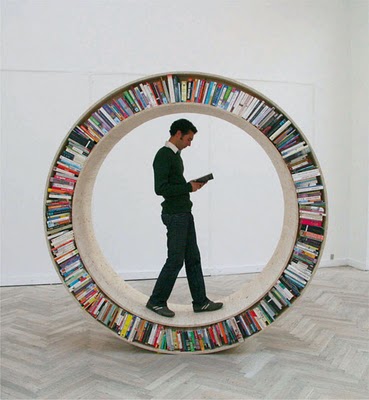
No attribution at present for artist/designer. Click pic for more.
That’s from a blog called Bioephemera, which asks its readers if anybody knows who made thing [UPDATE April 23,2010: Core77 mentions this object and its creator: David Garcia], and also points to this somewhat similar item:
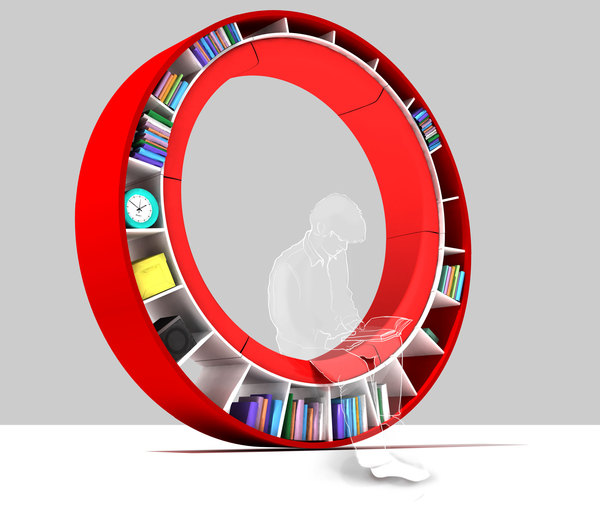
By Irina Zhdanova, click for detiails.
This post is part of a series.
Monocle has launched a “book collection,” with a reprint.
First in the series is a limited edition of Alain de Botton’s The Pleasures and Sorrows of Work. Originally published by Penguin, each book is printed on (retin-a) quality paper, bound in linen and signed by the author. They also contain an exclusive DVD interview.

£60
I’m quite interested in the idea of a sort of fancy, limited version of a book that was actually published earlier by a mainstream house. What do you think of that concept?
It’s a little odd in that the conventional thought would be to do this concurrently (or to reprint a more obscure “forgotten,” older book), I think. But I think this timing, as a kind of almost-belated endorsement, is rather interesting.
That said, Caleb Crain absolutely kicked the shit out of this particular book in an NYT review last year. But I suppose that’s neither here http://pted.org/Propecia.php nor there.
Part of a series.
Via Harold Check. Part of a series.
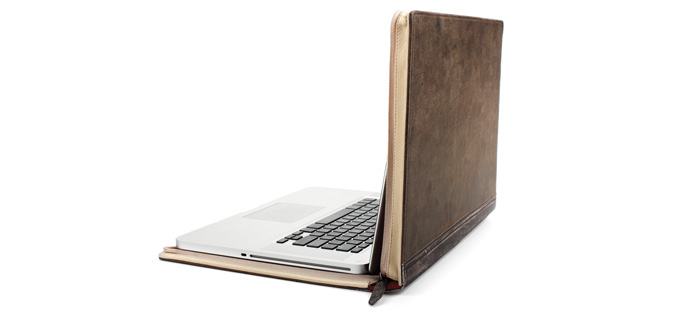
BookBook, click for more.
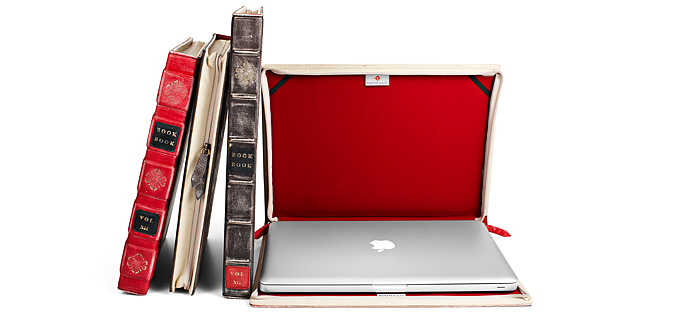
BookBook, Click for more.
Posted Under:
The Designed Life
This post was written by Rob Walker on April 18, 2010
Comments Off on Books, the idea, cont’d: Laptop-disguising bookform
I’d been meaning to mention that Lisa Congdon’s Collection A Day blog, mentioned earlier here, is still awesome. The perfect excuse: the below, via Swiss Miss.
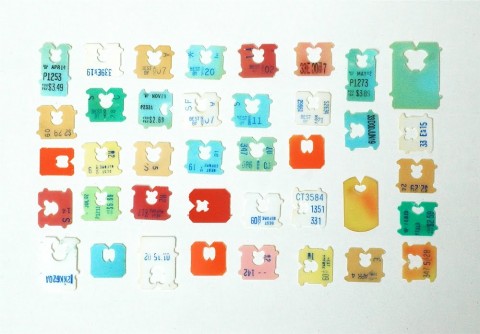
Day 107: Bread Bag Ties. Click for more.
This post is part of a series.
Posted Under:
Things/Thinking
This post was written by Rob Walker on April 18, 2010
Comments Off on Pictures of Stuff, cont’d: Bread Bag Ties




 "
"









































 Kim Fellner's book
Kim Fellner's book  A
A